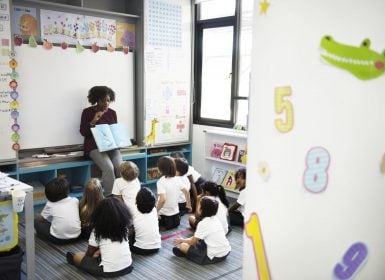
Counting is one of the first numeracy skills children learn. It lays the foundation that makes all mathematical learning possible. Teaching children to count in the early years is important for preparing them for success in maths when they start school.
When children start school, they will begin learning basic maths concepts like addition, subtraction, multiplication and division. Counting is the enabler for all operations, we count forwards for addition, backwards for subtraction and in equal groups for multiplication and division.
When should children start counting?
Children can develop counting skills at very different rates. Many children will be able to recite the numbers in order from an early age and may even begin to recognise up to 3 dots as 3 without counting. From three years, children who engage in number activities will keep growing their knowledge and skills. The Australian Curriculum suggests that children should be able to count to at least 20 in their first year of school.
How do children learn to count?
The Seven Counting Principles for Early Numeracy Development
Counting may seem simple but it involves more than reciting the numbers one to ten. Children need to be able to understand the meaning of numbers and how they relate to objects and quantity. There are seven counting principles children need to learn progressively to be able to count a group of objects effectively.
- Stable order – The first step in mathematics for children to master is the repeated pattern of counting (e.g., 1, 2, 3, 4, 5 and so on) and understanding that the order of numbers doesn’t change (i.e. 1, 2, 5, 3, 4). Many children begin to understand this from an early age, enjoying saying the counting pattern aloud.
- One-to-one correspondence – Once children understand the stable order of counting, they begin to learn how to count a group of objects by saying a number for each object in the group. This is known as one-to-one correspondence, each object in a group can only be counted once.
- Cardinality – When children can correctly count each item in a group using one-to-one correspondence and stable order, they start to understand the concept that the last number counted represents the total number of items in a group. They can answer the question ‘how many?’ without counting each item again.
- Conservation – Children will then extend their understanding that the total number of objects does not change if the objects are rearranged i.e., if you move the objects closer together or very far apart, the number of objects in the group remains the same.
- Order irrelevance – One of the more advanced early counting concepts is an understanding that you can start counting from any position or in any order, i.e., right-to-left, top-to-bottom or randomised, as long as each item is only counted once, and the final item counted represents the total.
- Abstraction – Finally, children develop the understanding that the items counted can be different shapes, colours or sizes but still only represent one item and can be counted in the group to find the total.
- Subitising – These counting principles work together to build a strong concept of number for children, so they will be able to identify the number of objects in a small group without having to count them individually (e.g. knowing they rolled a 3 on a die without counting each of the dots) – this is how efficiency in working with number begins.
5 Ways to Build Counting Skills
Model counting
One of the first things you can do to help children learn to count is demonstrate counting in everyday activities. This could be as simple as holding up your fingers to show the number you are talking about. There are opportunities to model counting all around us – the number of stairs you climb, the buttons on your shirt, the pieces of cereal in your bowl.
Sing counting songs and rhymes
Singing and rhyming provide fun opportunities to practice counting. There are so many songs and rhymes to choose from and each one can support a different counting principle.
Counting songs like ‘1, 2, 3, 4, 5, Once I Caught a Fish Alive’ and ‘The Ants Go Marching’ help children practice stable order while songs like ‘Ten Little Fingers’ can support one-to-one correspondence.
Use hands-on activities
Concrete materials like counters, popsicle sticks and blocks can help children to establish the relationship between numbers and objects for subitising. Any object that you have multiple of can be used for counting activities. Hands-on activities help children to build one-to-one correspondence and understand the value of numbers.
Sorting games are a fun and simple hands-on activity for building counting skills. Use items like pom poms or buttons and have children sort them into compartments of an ice cube or muffin tray. This can also help to build fine motor skills!
Play with dice and dominoes
Dice and dominoes can be used in so many ways to build children’s counting skills. When you roll a die you can count the number of dots facing up to get the total and then count the same number of spaces to move in a board game. In just one roll, children are practicing stable order, one-to-one correspondence, cardinality and subitising.
Play hopscotch
This popular playground game is a fun and simple way to practice different counting patterns. Start out by drawing the numbers one through ten to practice stable order and counting back. Once children are ready to progress, you can change the squares to practice skip counting by 2s, 5s and 10s, which can help build the foundations for multiplication.
Helpful Counting Sequences and Patterns
Here are a few sequences you can practice helping children reinforce their counting skills, after they have understood the principles of counting.
Counting forwards and backwards – This helps children to understand the order that numbers are said (stable order) and forms the foundation for later addition and subtraction.
Counting on from any number – Once children understand number order, they can then begin to practice counting from any number (e.g., start from five instead of one and continue to ten).
Skip counting – Start introducing counting by equal groups of 2s, 5s and 10s to build the foundation for multiplication.
By making counting part of everyday activities in early childhood, you can help to ensure children have a strong foundation for more advanced maths skills when they enter school. Counting is the foundation skill that makes all other maths learning possible, you can help your child be ready for learning maths by helping them to confidently count! The most important thing is to make it fun!


